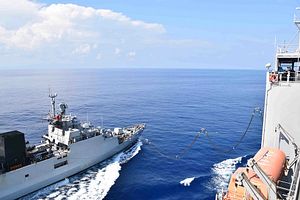A United States Merchant Marine vessel conducted a replenishment-at-sea (RAS) for an Indian Navy corvette in the South China Sea, the U.S. Pacific Fleet announced on Tuesday. USNS Richard E. Byrd, a Clark-class dry cargo and ammunition ship, conducted the RAS with INS Kiltan, an Indian Navy anti-submarine warfare corvette.
“Having the opportunity to work alongside our Indian Navy partners carries a lot of value,” said Capt. Lee Apsley, ship’s master for USNS Richard E. Byrd, according to a U.S. Navy Task Force 73 press release.
“Opportunities like this allow us to enhance our combined capabilities to effectively sustain operations and to maintain our readiness to respond to any maritime challenges that we might face together,” Capt. Apsley added.
INS Kiltan, along with INS Sahyadri, had made a port call in Manila from October 23 to 26. The vessel had operated in the Gulf of Thailand and the South China Sea for weeks, making other port calls in Kota Kinabalu, Malaysia, Laem Chabang, Thailand, and Sihanoukville, Cambodia.
INS Kiltan was commissioned into the Indian Navy in October 2017 and is the third Kamorta-class anti-submarine warfare corvette built for the Indian Navy.
The RAS, the first reported in the South China Sea between the two countries, comes after the first such operation two years ago after the operationalization of the U.S.-India Logistics Exchange Memorandum of Agreement (LEMOA). The first U.S.-India RAS took place in the Sea of Japan between USNS John Ericsson and INS Satpura.
The activity comes amid growing U.S.-India cooperation in the Indo-Pacific, including in the South China Sea.
Earlier this year, for the first time, the United States Navy, the Japan Maritime Self-Defense Force, the Philippine Navy, and the Indian Navy sailed together in the South China Sea, demonstrating a joint presence.
Six vessels were present for that transit through disputed international waters in the South China Sea. “The ships conducted formation exercises, communication drills, passenger transfers and held a leadership exchange aboard JS Izumo,” a U.S. Navy 7th Fleet release noted at the time.
“Events like this provide opportunities for like-minded navies to train together and promote maritime cooperation throughout a free and open Indo-Pacific,” it added.
The U.S. has encouraged India to continue its presence in the South China Sea. Unlike the United States, which conducts regular freedom of navigation operations in the region to underscore excessive maritime claims by regional states, including China, New Delhi primarily conducts port calls and presence operations in the region.

































